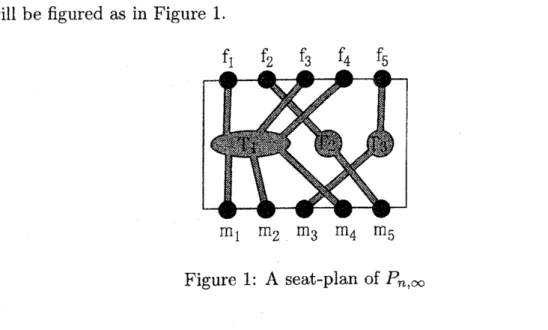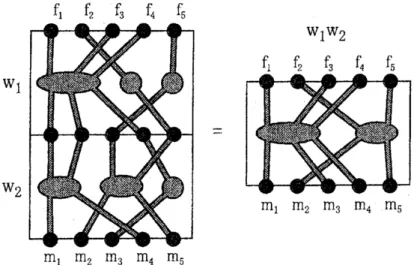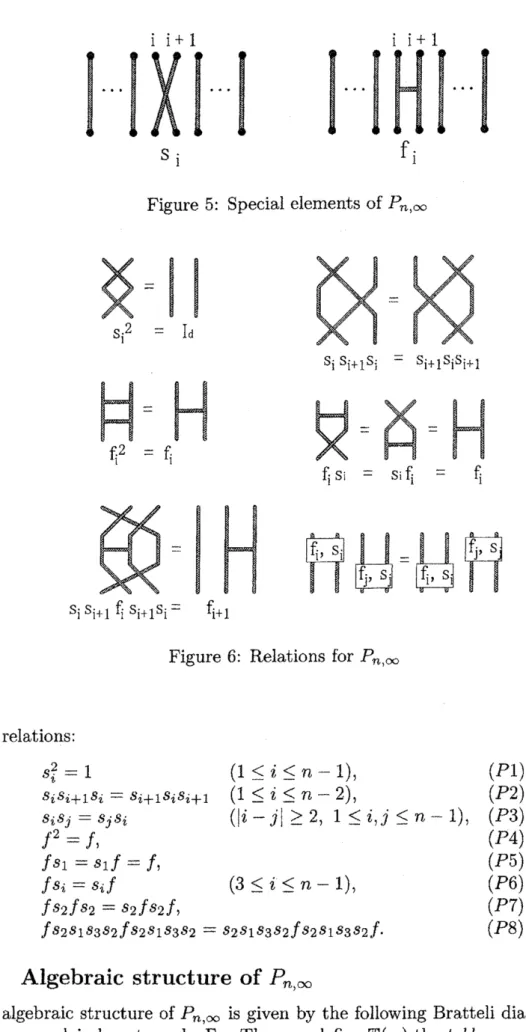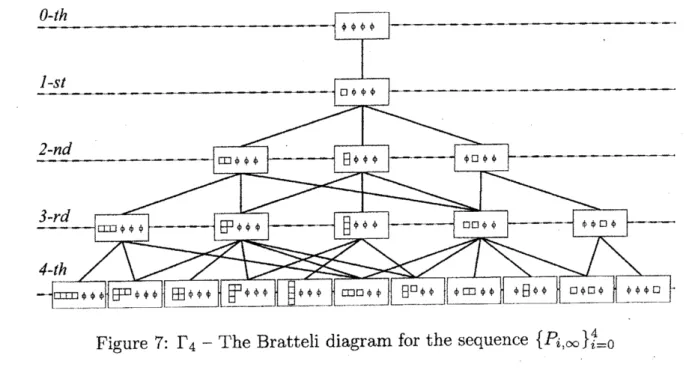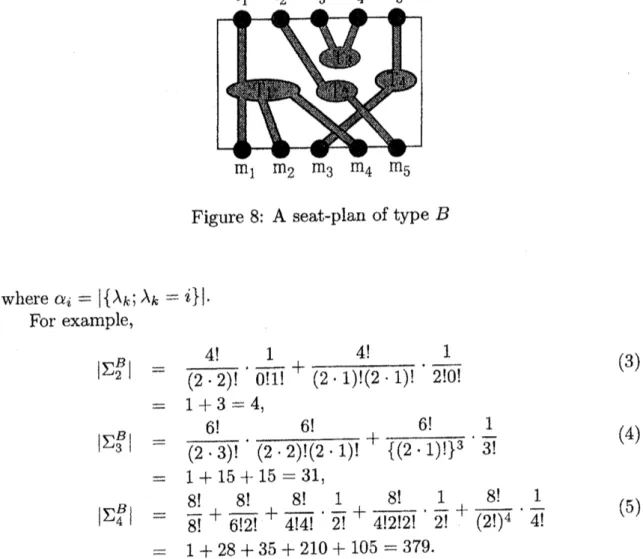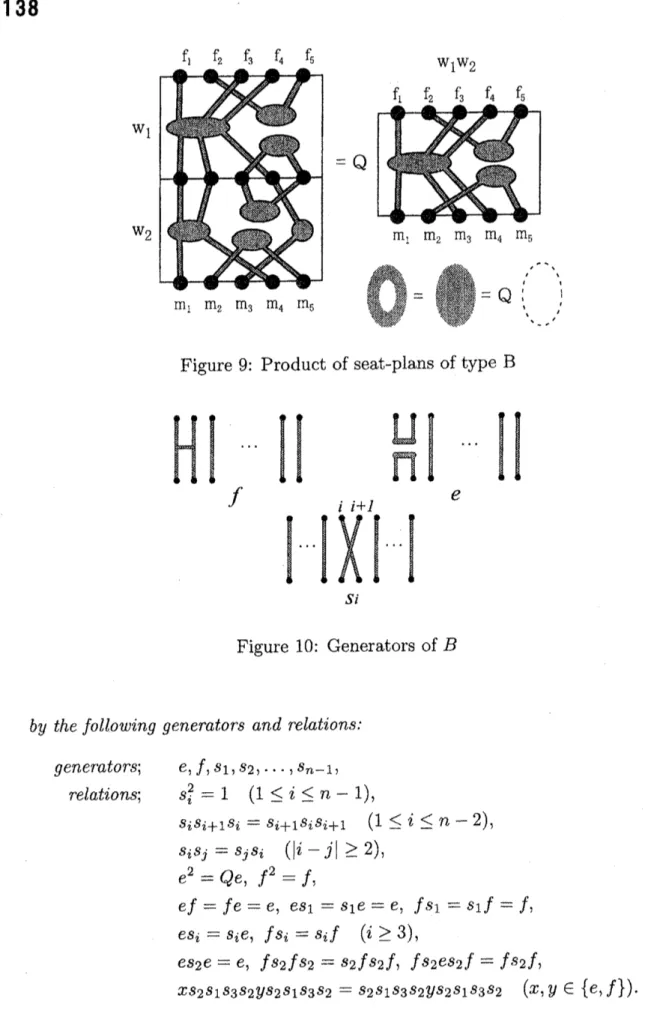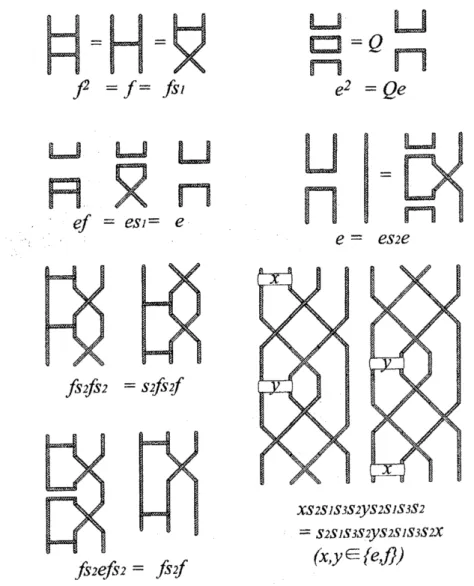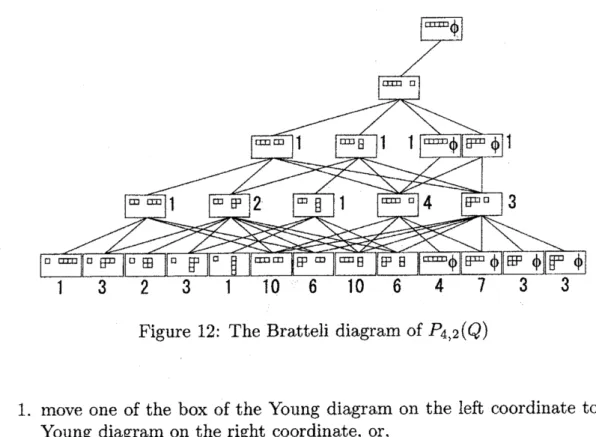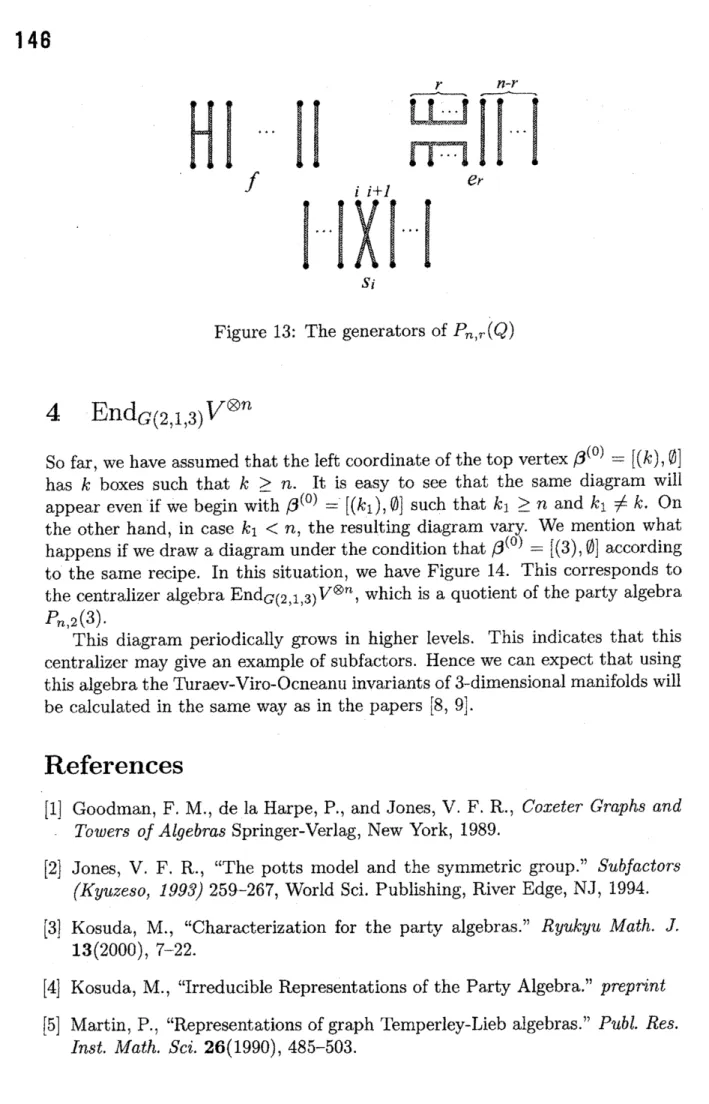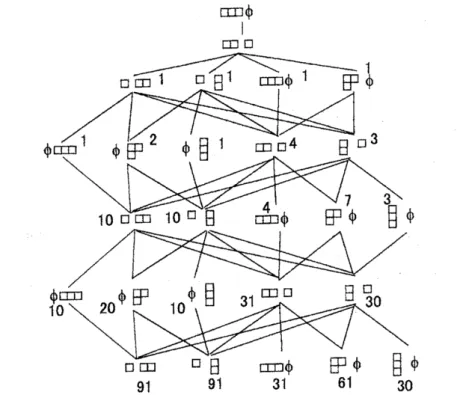On
the
structure
of
the party algebra of
type
$B$Masashi KOSUDA
Although in the talk at Kyoto-RIMS
we
used the notation $\overline{A}_{n}$ and $B_{n}$ tostand for the party algebra of type $\tilde{A}$
and $B$ respectively, in the following we
use the notation $P_{n,\infty}$ and $P_{n,2}(Q)$ respectively since after the talk
we
haveobtained general definition of the party algebra $P_{n,r}(Q)$ which is defined from
the centralizer algebra of the unitary reflection group $G(r, 1, k)$
.
This relationis discussed in Section 3.
1
$P_{n,\infty}$:
Party
algebra of
type
$\tilde{A}$
Before consider the party algebra oftype $B(=P_{n,2}(Q))$, we introduce $P_{n}$,
$\infty$ the party algebra of type $\tilde{A}$
.
There also exists the party algebra oftype $A$ (no tilde) called the partition
algebra whichcorresponds to $P_{n,1}(Q)$ in our notation. However, we do not treat
this one, since it
was
intensively studied in the papers [2, 5, 6, 7].1.1
Definition
of
a
seat-plan of type
$\tilde{A}$Suppose that there exist two parties each ofwhich consists of$n$ members. The
parties hold meetings splitting into several sm all groups. Every group consists of the
same
number of members of each party. The set of such decompositionsintosmall groups makes
an
algebra$P_{n}$,$\infty$ under a certain product and it is called
the party algebra
of
type $\tilde{A}$.
More precisely
we
consider the following situation. Let $F=\{f1, f_{2}, \ldots, f_{n}\}$and $M=\{m_{1}, m_{2}, \ldots , m_{n}\}$ be two sets each of which consists of $n$ distinct
elements such that $F\cap M=\emptyset$
.
We decompose $F\lfloor\lrcorner M$ into subsets$\Sigma_{n}$ $=$ $\{\{T_{1}, T_{2}, \ldots, T_{n}\}|$
$j=1\mathrm{u}T_{j}n=F\cup M$, $|T_{1}|\geq|T_{2}|\geq$ . .
.
$\geq|T_{n}|$,$|T_{j}\cap F|=|T_{j}\cap M|$ for $j=1,2$, $\ldots$, $n$, $T_{i}\cap T_{\acute{J}}=\emptyset$ if $\mathrm{i}\neq j$
}
We call such a partition into subsets a seat-plan of type $\tilde{A}$
.
A seat-plan of type $\tilde{A}$is geometrically expressed. For example
132
will be figured as in Figure 1.
$\mathrm{F}$Figure 1: A seat-plan of$P_{n}$,
$\infty$
However this geometrical expression is not unique. For example, the $\mathrm{f}\mathrm{o}\mathrm{l}\mathrm{l}\mathrm{o}\mathrm{w}rightarrow$
ing two figures in Figure 2 express the same seat-plans.
$\sim$
Figure 2: $\{\{f1, f_{2}, m_{1}, m_{2}, \}, \{fs, f_{4}, m_{3}, m_{4}\}, \{f_{5}, m_{5}\}\}$
Here
we
consider how many seat-plans of $P_{n}$,$\infty$ exist for an integer $n$
.
Let$P(n)$ be
a
set of partitions of $n$. Then there exists a partition A $\in P(n)$ suchthat $\lambda=$ $(\lambda_{1}, \lambda_{2}, \ldots, \lambda_{n})=(|T_{1}|/2, |T_{2}|/2, \ldots , |T_{n}|/2)$. Then the number of
seat-plans is
$| \sigma_{n}|=\sum_{\lambda\in P(n)}(\frac{n.!}{\lambda_{1}!\lambda_{2}!\cdot\cdot\lambda_{n}!})^{2}\cdot\frac{1}{\alpha_{1}!\alpha_{2}!\cdots\alpha_{n}!}$ ,
where $\alpha_{i}=|\{\lambda_{k;}\lambda_{k}=\mathrm{i}\}|$
.
For example,we
find $|\sigma_{3}|=16$as
follows:$|\sigma_{3}|$ $=$ $\sum$ $( \frac{3!}{\lambda_{1}!\lambda_{2}!\lambda_{3}!})^{2}\cdot\frac{1}{\alpha_{1}!\alpha_{2}!\alpha_{3}!}$
$\lambda\in P(n)$
$=$ $( \frac{3}{3!00!}!.)^{2}$
.
$\frac{1}{0!\mathrm{O}!1!}+(\frac{3!}{2!1!0!})^{2}\cdot\frac{1}{0!1!1!}+(\frac{3}{1!11!}!.)^{2}\cdot\frac{1}{3!0!0!}$ $=$ 16.1.2
The
set of
seat-plans
$\Sigma_{n}$makes
an
algebra
$P_{n}$,$\infty$
For seat-plans $w_{1}$, $w_{2}\in\Sigma_{n}$, the product is defined as in Figure 3.
$\mathrm{w}_{1}\mathrm{w}_{2}$
$\mathrm{w}_{1}$
$\mathrm{w}_{2}$
$\mathrm{m}_{1}$ $\mathrm{m}_{2}$ $\mathrm{m}_{3}$ $\mathrm{m}_{4}$ $\mathrm{m}_{5}$
Figure 3: Product of seat-plans
It is easy to see that the identity is given by the seat-plan
$\{\{f_{1},m_{1}\}, \{f_{2}, m_{2}\}, \ldots, \{f_{n}, m_{n}\}\}$,
which is figured in Figure 4.
$\ovalbox{\tt\small REJECT}$ $\ovalbox{\tt\small REJECT}$
. $\ovalbox{\tt\small REJECT}$
Figure 4: Identity of $A_{n}$
We understand that $P_{0,\infty}=P_{1,\infty}=\mathbb{Q}(\sqrt{2}, \sqrt{3}, \ldots, \sqrt{n})$
.
1.3
Characterization
for the
party
algebra
$P_{n}$,$\infty$
In the paper [3], we gave a presentation of the party algebra $P_{n}$,
$\infty$ by using
tokoroten method. According to the paper, the party algebra $P_{n,\infty}$ is generated
by the
se
at-plans in Figure 5 (Here $f_{i}$ does not express avertexon
the top line),which satisfies the relation illustrated in Figure 6.
In Figure 6, the relation $s_{i}s_{i+1}f_{i}s_{i+1}s_{i}=f_{\mathrm{z}+1}$
means
$P_{n}$,$\infty$ is actually
gen-erated by $f=f_{1}$ and the symmetric group $\langle s_{1}, s_{2}, \ldots, s_{n-1}\rangle$
.
Hencewe
haveobtain the following characterization of the party algebra $P_{n}$,
$\infty$ by generator $\mathrm{s}$
134
11
$\ovalbox{\tt\small REJECT}$ $\cdots\ovalbox{\tt\small REJECT}$ $\ovalbox{\tt\small REJECT}$ $\cdots\ovalbox{\tt\small REJECT}$ $\ovalbox{\tt\small REJECT}$ $\cdots\ovalbox{\tt\small REJECT}$ $\ovalbox{\tt\small REJECT}$ $\cdots\ovalbox{\tt\small REJECT}$
$\mathrm{S}\mathrm{i}$
Figure 5: Special elements of$P_{n}$,
$\infty$
$=\ovalbox{\tt\small REJECT}$ $\ovalbox{\tt\small REJECT}$
$–$ $\mathrm{I}_{\mathrm{d}}$
$\mathrm{s}_{\mathrm{i}}\mathrm{s}_{\mathrm{i}+1^{\mathrm{S}}\mathrm{i}}$ $=\mathrm{s}_{\mathrm{i}+1^{\mathrm{S}}\mathrm{i}^{\mathrm{S}}\mathrm{i}+1}$
$\ovalbox{\tt\small REJECT}$
$\mathrm{f}_{\mathrm{i}+1}$
Figure 6: Relations for $P_{n}$
,$\infty$
and relations:
$s_{i}^{2}=1$ $(1 \leq \mathrm{i}\leq n-1)$, (P1) $s_{i}s_{i+1}s_{i}=s_{i+1}s_{i}s_{i+1}$ $(1\leq \mathrm{i}\leq n-2)$, (P2) $s_{i}s_{j}=fjSi$ $(|\mathrm{i}-j|\geq 2,1\leq \mathrm{i},j\leq n-1)$, (P3)
$f^{2}=f$, (P4)
$fs_{1}=s_{1}f=f$, (P5)
$fs_{i}=s_{i}f$ $(3\leq i\leq n-1)$, (P6)
$fs_{2}fs_{2}=s_{2}fs_{2}f$, (P7)
$fs_{2}s_{1}s_{3}s_{2}fs_{2}s_{1}s_{3}s_{2}=s_{2}s_{1}s_{3}s_{2}fs_{2}s_{1}s_{3}s_{2}f$
.
(P8)1.4
Algebraic
structure
of
$P_{n,\mathrm{m}}$The algebraic structure of$P_{n}$,
$\infty$ is given by the following Bratteli diagram $\Gamma_{n}$
.
for $\alpha\in\Lambda_{n}(n)$, where $\Lambda_{n}(n)$ is the set of vertices
on
the bottom of $\Gamma_{n}$.
Figure 7: $\Gamma_{4}-$ The Bratteli diagram for the sequence $\{P_{i,\infty}\}_{i=0}^{4}$
The following is the recipe for drawing $\Gamma_{n}$. Fix
a
positive integer $n$.
Let$\alpha$ $=$ [$\alpha(1)$, $\ldots$ , a(n)]
be
an
$n$-tuple of Young diagrams. The j-th coordinate of the tuple is referredto the j-th board. The height $||\alpha||$ of $\alpha$ is defined
as
the weightsum
of the sizesof all the $|\alpha(j)|\mathrm{s}$. Namely, $||\alpha||$ is defined by
$|| \alpha||=\sum_{j=1}^{n}j|\alpha(j)|$
.
Let
$\Lambda_{n}(\mathrm{i})=\{\alpha=[\alpha(1), \ldots , \alpha(n)]|||\alpha||=\mathrm{i}\}$
be a set of $n$-tuples of height $\mathrm{i}$
.
For $\alpha$ $\in\Lambda_{n}(\mathrm{i})$,we
set $\alpha(0)=n-\mathrm{i}$ (thehorizontal Young diagram of depth 1 and of width $n-\mathrm{i}$) if necessary. Let $\alpha\prec\tilde{\alpha}1$
or
$\tilde{\alpha}\succ_{\mathrm{x}}\alpha$ denote that$\tilde{\alpha}$ is
obtained
from $\alpha$ by removingone
box from theYoungdiagram
on
the j-th board and adding the box to the Young diagram on the$(j+1)- \mathrm{s}\mathrm{t}$ board for
some
$j(0\leq j\leq n-1)$.
The diagram$\mathrm{F}_{n}$ is defined
as
theHasse diagram $\Gamma_{n}$ ofLJ
$i=0$,$\ldots nn\mathrm{A}(\mathrm{i})$ with respect to the order generated by $\succ 1\mathrm{s}$
.
Finally we define the sets of the tableaux
on
$\Gamma_{n}$.
For $\alpha\in\Lambda_{n}(n)$, The set $\mathrm{T}(\alpha)$ of tableauxof
shape $\alpha$ is defined by$\mathrm{T}(\alpha)$ $=$ $\{P=(\alpha^{(0)}, \alpha^{(1)}, \ldots, \alpha^{(n\rangle})|\alpha^{(0)}=[\emptyset, \ldots, \emptyset]$ ,
$\alpha^{\langle n)}=\alpha$,
$\alpha^{(i)}\prec\alpha^{(i+1)}1$ for $0\leq \mathrm{i}\leq n-1$
}.
?36
Theorem 1. Let$\mathbb{Q}$ be the
field
of
rational
numbers and$K_{0}=$ $\mathrm{Q}(\sqrt{2}, \sqrt{3}, \ldots, \sqrt{n})$its extension.
If
toedefine
$\mathrm{V}(\alpha)$ $=\oplus_{P\in \mathrm{T}(\alpha)}K_{0}v_{P}$ as avectorspace over$K_{0}$ withthe standard basis $\{v_{P}|P\in \mathrm{T}(\alpha)\}$, then we have
$P_{n,\infty}\cong\alpha\in\Lambda_{\tau},(n)\oplus$ End(V(a)). (1)
For the proof of the theorem above
we
refer the paper [4]. In the paper [4],we
constructed concrete isomorphism in the equation (1).2
$P_{n,2}(Q):\mathrm{P}\mathrm{a}\mathrm{r}\mathrm{t}\mathrm{y}$algebra
of
type
$B$Next
we
consider $P_{n,2}(Q)$ the party algebra oftype $B$.2.1
Definition
of
a
seat-plan
of type
$B$Suppose againthat there exist two parties each of which consists of$n$ members.
The parties hold meetings splitting into several small
groups.
Every groupconsists of
even
number of members. Some groups may consist of members ofjust
one
of the parties. The set of decompositions into small groups makesan
algebra $P_{n,2}(Q)$ and it is called the party algebra
of
type $B$.
More precisely
we
consider the following situation. Let $F=\{f_{1}, f_{2}, \ldots , f_{n}\}$and $M=\{m_{1}$,$m_{2}$,.
.
. ,$m_{n}$$\}$ be two sets each of which consists of $n$ distinctelements such that $F\cap M=\emptyset$
.
We decompose $F\cup$$M$ into subsets$\Sigma_{n}^{B}$ $=$ $\{\{T_{1}, T_{2}, \ldots, T_{n}\}|$
$j=1\mathrm{u}T_{j}n=F\mathrm{U}M$, $|T_{1}|\geq|T_{2}|\geq\cdots\geq|T_{n}|$, $T_{i}\cap T_{j}=\emptyset$ if $\mathrm{i}\neq j$
$|T_{j}|$ :even, $j=1,2$,$\ldots$ ,$n$
}.
We call such a partition into subsets a seat-plan of type $B$
.
A seat-plan of type $B$ is also geometrically expressed. For example$\Sigma_{5}^{B}\ni w_{1}=\{\{f_{1},m_{1},m_{2}, m_{4}\}, \{f_{2}, m_{5}\}, \{f_{3}, f_{4}\}, \{f_{5}, m_{3}\}\}$
will be figured as in Figure 8.
Similarly to the
case
of type $\tilde{A}$we consider how many seat-plans of type $B$
exist for a given integer $n$
.
Since
we
do not have to distinguish the elements of$F$ and $M$, the numberof seat-plans of type $B$ is given by the follow $\mathrm{i}\mathrm{n}\mathrm{g}$:
Figure 8: A seat-plan oftype $B$
where $\alpha_{i}=|\{\lambda_{k;}\lambda_{k}=\mathrm{i}\}|$
.
For example,
$|\Sigma_{2}^{B}|$ $=$ $\frac{4!}{(2\cdot 2)!}$
.
$\frac{1}{0!1!}+\frac{4!}{(2\cdot 1)!(2\cdot 1)!}\cdot\frac{1}{2!0!}$ (3)$=$ $1+3=4$,
$|\Sigma_{3}^{B}|$ $=$ $\frac{6!}{(2\cdot 3)!}$
.
$\frac{6!}{(2\cdot 2)!(2\cdot 1)!}+\frac{6!}{\{(2\cdot 1)!\}^{3}}$.
$\frac{1}{3!}$ (4)
$=$ $1+15+15=31$,
$|\Sigma_{4}^{B}|$ $=$ $\frac{8}{8}!$
.
$+ \frac{8!}{6!2!}+\frac{8!}{4!4!}$.
$\frac{1}{2!}+\frac{8}{4!22!}!$. .
$\frac{1}{2!}+\frac{8!}{(2!)^{4}}$ .$\frac{1}{4!}$ (5)
$=$ $1+28+35$ $+210+105=379$
.
2.2
The
set of
$\mathrm{s}\mathrm{e}\mathrm{a}\mathrm{t}rightarrow \mathrm{p}\mathrm{l}\mathrm{a}\mathrm{n}\mathrm{s}$ $\Sigma_{n}^{B}$also makes
an
algebra
$F_{n,2}(Q)$For seat-plans $w_{1}$,$w_{2}\in\Sigma_{n}^{B}$, the product is also defined
as
in Figure 9.In
case
$d$shaded islandsoccur
inthe product, firstremove
holes in the islands(if they exist) and then multiply the resulting diagram by $Q^{d}$ removing the $d$
islands.
2.3
Characterization
for the
party
algebra
$P_{n,2}(Q)$We
can
also give apresentation
of the party algebra of type $B$ by using thetokoroten method. The generators
are
given by the seat-plans as in Figure 10.We
can
easily check that these generators satisfy the relationsillustrated
in Figure 11. More precisely,we
have the followingproposition.
138
Figure 9: Product of seat-plans oftyPe $\mathrm{B}$
$\ovalbox{\tt\small REJECT}$ ... $\ovalbox{\tt\small REJECT}$
$\ovalbox{\tt\small REJECT}$ $\ovalbox{\tt\small REJECT}\ovalbox{\tt\small REJECT}\{$
$\ovalbox{\tt\small REJECT}$ $\{$
$f$ $e$
$\ovalbox{\tt\small REJECT}$ $\cdots\ovalbox{\tt\small REJECT}$
Si
Figure 10: Generators of $B$
by the following generators and relations:
generators; $e$, $f$,$s_{1}$, $s_{2}$, $\ldots$ , $s_{n-1}$,
relations; $s_{i}^{2}=1$ $(1 \leq i\leq n-1)$,
$s_{i}s_{i+1}s_{i}=s_{i+1}s_{\mathrm{t}}s_{i+1}$ $(1\leq i\leq n-2)$, $s_{i}s_{j}=s_{j}s_{i}$ $(|i-j|\geq 2)$,
$e^{2}=Qe$, $f^{2}=f$,
$ef=fe=e$
, $es_{1}=s_{1}e=e$, $fs_{1}=s_{1}f=f$,$es_{i}=s_{i}e$, $fs_{i}=s_{i}f$ $(\mathrm{i}\geq 3)$,
$es_{2}e=e$, $fs_{2}fs_{2}=s_{2}fs_{2}f$, $fs_{2}es_{2}f=fs_{2}f$,
LJ
$\ovalbox{\tt\small REJECT}$ $\ovalbox{\tt\small REJECT}\ovalbox{\tt\small REJECT}=Q\ovalbox{\tt\small REJECT}$$e^{\mathit{2}}=Qe$
$\ovalbox{\tt\small REJECT}\ovalbox{\tt\small REJECT} ef$
$=es=\ovalbox{\tt\small REJECT}_{J}\ovalbox{\tt\small REJECT} e\ovalbox{\tt\small REJECT}\ovalbox{\tt\small REJECT}$
$\ovalbox{\tt\small REJECT}\ovalbox{\tt\small REJECT}$ $\ovalbox{\tt\small REJECT}$
$=$ $e=eS\mathit{2}e$
fs2fs2
$=s\mathit{2}fs\mathit{2}f$ $XS\mathit{2}SIS\mathit{3}S\mathit{2}ys\mathit{2}SlS\mathit{3}S\mathit{2}$ $=s\mathit{2}SlS\mathit{3}S\mathit{2}ys\mathit{2}SlS\mathit{3}S\mathit{2}X$ $(x,y\in fe,fll$Figure 11: Relations for $P_{n,2}(Q)$
2.4
Algebraic
structure
of
$F_{n,2}(Q)$The algebraic structure of$P_{n_{)}2}(Q)$ is given by the following:
$P_{n,2}(Q)\cong\beta\in\oplus_{\Lambda_{\mathfrak{n}}^{B}}$
End(W $(\beta)$),
and the Bratteli diagram of $P_{n,2}(Q)$ is given by Figure 12.
Here
we
explain the recipe for drawing the Brattelidiagram. In the followingwe
fixan
integer $k$so
that $k\geq n$.
First putan
vertexindexed by apair ofYoungdiagram $[(k), \emptyset]$ on the O-th floor. Then
move
the right most box in the Youngdiagram in the left
coordinate
to the right coordinate. Put a vertex indexed bythe resulting pair ofYoung diagrams under the first vertex (l-st floor) and join
these vertices by
an
edge. The index set of the vertices on the $(\mathrm{i}+1)- \mathrm{s}\mathrm{t}$ floor$\Lambda_{B}(\mathrm{i}+1)$ is
obtained
from the index set of the vertices on the i-th floor$\Lambda_{B}(\mathrm{i})$
140
Figure 12: The Bratteli diagram of $P_{4,2}(Q)$
1. move
one
of the box of the Young diagramon
the left coordinate to theYoung diagram on the right coordinate, or,
2. move one of the box of the Young diagram
on
the right coordinate to theYoung diagram
on
the left coordinate,so that the resulting pair again become a pair ofYoung diagrams. A vertex on
the i-th floor indexed by $\beta_{1}\in\Lambda_{B}(\mathrm{i})$ and another vertex $(\mathrm{i}+1)-\mathrm{s}\mathrm{t}$ floor indexed by $\beta_{2}\in\Lambda_{B}(\mathrm{i}+1)$ is joined by
an
edge if and only if$\beta_{2}$ is obtained from $\beta_{1}$ bythe recipe above. Let $\mathbb{T}(\beta)$ be the set of paths from the top vertex $\beta$ $=[(k), \emptyset]$
to the vertex $\beta$
on
the n-th floor. More preciselywe
define$\mathbb{T}(\beta)$ $=$ $\{P=(\beta^{(0)}, \beta^{(1)}, \ldots, \beta^{(n)})|\beta^{(i)}\in\Lambda_{B}(\mathrm{i})(0\leq i\leq n)$, $\beta^{(0)}=[(k)7\emptyset]$, $\beta^{(n)}=\beta$,
$\beta^{(\mathrm{i})}$ and $\beta^{(i+1)}$ are joined by an edge $(0\leq \mathrm{i}\leq n-1)\}$
.
Let $W(\beta)=\langle v_{P}|P\in \mathrm{T}(\beta)\rangle$ be a vector space
over
$\mathbb{Q}(\sqrt{2}, \sqrt{3}, \ldots, \sqrt{k})$ whosestandard basis is indexed by the elements of $\mathbb{T}(\beta)$.
Note that square
sums
of the numberson
each floor in Figure 12 is equal tothe number ofseat-plans of type $B$ given in the equations (3)(4) and (5).
2.5
Construction of
irreducible
representations
For a generator $s_{i}$ of $P_{n,2}(Q)$,
we
define a linear mapon
$V(\beta)$ giving a matrix$B_{\dot{\mathrm{t}}}$ with respect to the basis $\{v_{P}|P\in \mathbb{T}(\beta)\}$
.
Namely, for a pair of tableaux$P=$ $(\beta^{(0)},\beta^{(1\rangle}, \ldots,\beta^{(n)})$ and $Q=(\beta^{\prime(0)},\beta^{\prime(1)}, \ldots,\beta^{\prime(n)})$ of$\mathbb{T}(\beta)$ define$B_{i}v_{\mathrm{P}}=$
$\sum_{Q\in \mathrm{T}(\beta)}(B_{i})_{QP}v_{Q}$
.
If there isan
$i_{0}\in\{1,2, \ldots, n-1\}$ $\backslash \{\mathrm{i}\}$ such that $\beta^{(i_{\mathrm{O}})}\neq$$\beta^{\prime(i\mathrm{o})}$, then
we
putIn the following,
we
consider thecase
that for $\mathrm{i}_{0}\in\{1$,2, $\ldots,n-$$1\}\backslash \{\mathrm{i}\}$
.
First, we consider the case $\beta^{(i)}$ is obtained from $\beta^{(i-1)}$ by moving
a
boxin the Young diagram
on
the left [resp. right] board to the Young diagram on the other board and $\beta^{(i+1)}$ is obtained from $\beta^{(i)}$ by moving another box in theYoung diagram againonthe left [resp. right] board to theYoung diagram
on
the other board. Denote the Young diagramon
the left board of$\beta^{(i-1)}$ [resp. $\beta^{(i)}$,$\beta^{(i+1)}]$ by $\lambda^{(i-1)}$ [resp. $\lambda^{(i)}$, $\lambda^{(i+1\rangle}$] and denote the Young diagram
on
the rightboard of $\beta^{(\mathrm{i}-1)}$ [resp. $\beta^{(i)}$, $\beta^{(i+1)}$] by $\mu^{(i-1)}$ [resp. $\mu^{(i)}$, $\mu^{(i+1)}$]. Let $\lambda’\subseteq\lambda 1$ or
$\lambda\supset\lambda’1$ denote that
$\lambda’$ is
obtained
from A by removingone
box. Recall that if$\nu\subseteq\mu\subseteq\lambda 11$’ then
we can
define the axial distance$d=$ a$(\nu, \mu, \lambda)$. Namely if$\mu$ differs
from$\nu$ in its $r_{0}$-th row and co-th columnonly, and if A differs from
$\mu$ in its $r_{1}$-th
row and $c_{1}$-th column only, then $d=d(U, \mu, \lambda)$ is defined by
$d=d(\nu, \mu, \lambda)=(c_{1}-r_{1})-(c_{0}-r\mathrm{o})=\{$
$h_{\lambda}(r_{1,0_{r}}c)-1$ if $r_{0}\leq r_{1}$, $1-h_{\lambda}(r_{0}, c_{1})$ if $r_{0}>r_{1}$.
Here $h_{\lambda}(i,j)$ is the hook-length at $(\mathrm{i},j)$ in A and for $\lambda=$ ($\lambda_{1}$,A2,
$\ldots$) the
hook-length $h_{\lambda}(\mathrm{i},j)$ is defined by
$h_{\lambda}(\mathrm{i},j)=\lambda_{i}-j+|\{\lambda_{l;}\lambda_{\ell}\geq j\}|-\mathrm{i}+1$
.
If $\lambda^{(i-1)}\supset\lambda^{(i)}\supset\lambda^{(i+1)}11$’ then $\mu^{(i-1)}\subseteq\mu^{(i)}\subseteq\mu^{(i+1)}11^{\cdot}$ Hence
we can
define the axialdistance $d_{1}=d(\lambda^{(i+1)}, \lambda^{(i)}, \lambda^{(i-1)})$ and $d_{2}=d(\mu^{(i-1)},\mu^{(i)}, \mu^{(i+1)})$. If $|d_{1}|\geq 2$
[resp. $|d_{2}|\geq 2$], then there is
a
uniqueYoung diagram$\lambda’\neq$ A [resp. $\mu’\neq\mu$] whichsatisfies $\lambda^{(i-1)}\supset\lambda’\supset 11$A
$(i+1)$ [resp. $\mu^{(i-1)}\subseteq\mu^{\mathit{1}}\subseteq\mu^{(\iota+1)}$]
$11^{\cdot}$ Similarly, if
$\lambda^{(i-1)}\subseteq\lambda^{(i)}\subseteq\lambda^{(i+1)}11$ ,
then$\mu^{(i-1)}\supset\mu^{(i)}\supset\mu^{(i+1)}11$’ and
we can
define the axial distance$d_{1}=d(\lambda^{(i-1)}, \lambda^{(i)}, \lambda^{(i)})$
and $d_{2}=d(\mu^{(i+1)}, \mu^{(i)}, \mu^{(i-1)})$
.
If $|d_{1}|\geq 2$ [resp. $|d_{2}|\geq 2$], then $\lambda’$ [resp. $\mu^{(i-1)}$]is defined as before. Let $Q_{1}$,$Q_{2}$,$Q_{3}$ be tableaux ofshape $\beta$ which
are
obtainedfrom $P$ by replacing $\beta^{(i\rangle}=[\lambda^{(i)}, \mu^{(i)}]$
on
the $j$-th and the $(j+1)- \mathrm{s}\mathrm{t}$ board of$\beta^{(i)}$ with $[\lambda^{(i)}, \mu’]$, $[\lambda’, \mu^{(i)}]$, $[\lambda’, \mu’]$ respectively. For the basis elements given by
the above tableaux,
we
define the linear map by the following matrix:$(v_{P}, v_{Q_{1}}, v_{Q_{2}}, v_{Q_{3}})\mapsto(v_{P}, v_{Q_{1}},v_{Q_{2}}, v_{Q_{3}})B_{i}$,
where
$B_{i}$ $=$ $($
$- \frac{1}{d_{1}}\sqrt{d_{2}^{\mathrm{T}}-\underline{1}}-\frac{1}{d_{1}\underline{d_{2}d_{2}^{2}}}$
$\sqrt{\underline{d}_{\xi d_{1}^{\mathrm{B}}}^{2}-1}\sqrt{\underline{d}\underline{1}\#}-\sqrt{\underline{d_{1\overline{d}}^{2}}-1}\frac{2_{-}d_{2}1}{-1d_{2}}-\frac{1}{d_{1}}\sqrt{\frac{\mapsto 1d_{2}^{2}}{d_{2}^{2}}}\frac{1}{d_{1}d_{2}}\ovalbox{\tt\small REJECT}$
.
Second,
we
consider thecase
that the only left boards of $\beta^{(i-1)}$ and $\beta^{(i+1)}$142
$(\mu\neq\mu’)$.
tet
$\{\lambda_{(r)}^{+}|r=1,2, \ldots , b(\lambda)\}$ [resp.{A
$(r)-,|r’=1$,2, $\ldots$ , $b(\lambda)’\}$]$\mathrm{b}\mathrm{e}$
the set of all the Young diagrams which satisfy $\lambda_{(r)_{1}}^{+}\supset$A [resp. $\lambda_{(r’)_{1}}^{-}\subseteq\lambda$] and let
$P_{1}$,$P_{2)}\ldots$ ,$P_{b(\lambda)}$ [resp. $Q_{1}$,$Q_{2}$,
$\ldots$, $Q_{b(\lambda)’}$] be all the tableaux which
are
obtainedfrom $P$ by replacing $\beta^{(i)}$ with
$[\lambda_{(r)}^{+}, \mu\cap\mu’]$ [resp. $[\lambda_{(r)}^{-}$, , $\mu\cup\mu’]$]. For the basis
elementsgiven bythe above tableaux,
we
definethe linear map bythe followingmatrix:
$(B_{i})_{P_{r},P_{r’}}$ $=$
$(B_{i})_{P_{r},Q_{r’}}$ $=$ $(B_{i})_{Q_{r’},P_{r}}=$
$(B_{i})_{Q_{r},Q_{r’}}$ $=$ 0.
Here $h(\nu)$ is the product of all the hook-lengths in $lJ$: $h(\nu)$
$= \prod_{(i,j)\in\nu}h_{l/}(\mathrm{i},j)$.
If $\beta^{(i-1)}=[\lambda, \mu]$ and $\beta^{(i+1)}=[\lambda’, \mu]$, then the matrix $(B_{i})$ is similarly defined
by replacing A with $\mu$ in the argument above. For example, let $P_{1}$ $=$ ($[k,$$0]$, [A –1, 1], $[k-2,2]$, [1(A-2), 1])
$P_{2}$ $=$ ($[k,$$0]$, [A –1,1], $[k-2,$ $1^{2}]$, [1$(k-2)$, 1])
$Q_{1}$ $=$ $([k, 0], [k-1,1], [1(k-1),, 0], [1(k-2), 1])$
be the tableaux of shape $[1(k-2), 1]$. Then the matrix $B_{2}$ with respect to this
basis is
(
$1/2$ $-1/\sqrt{2}1/21/2$ $-1/\sqrt{2}$$1/\sqrt{2}0$)
Next, we consider the
case
$\beta^{(i-1)}=\beta^{(i+1)}$.
We put $\beta^{(i-1)}=\beta^{(i+1)}=[\lambda, \mu]$.Let $\{\lambda_{(r)}^{+}\}$, $\{\lambda_{(r)}^{-},\}$, $\{\mu_{(s)}^{+}\}$ and $\{\mu_{(s)}^{-},\}$ be the sets of Young diagrams previously
defined and let $\{Q_{r’,s}\}$ and $\{P_{r,s’}\}$ be the sets of tableaux obtained from $P$
by replacing $\beta^{(\mathrm{z})}$ with
$[\lambda_{(r)}^{-},, \mu_{(s)}^{+}]$ and $[\lambda_{(r)}^{+}, \mu_{(s)}^{-},]$ respectively. For the basis
matrix:
$(B_{i})_{P,P’}$ $=$ $\ovalbox{\tt\small REJECT}$
$0$ otherwise.
For example, let
$Q_{1}$ $=$ $([k, 0], [k-1,1], [k-2,2], [k-1,1])$
$Q_{2}$ $=$ ($[k,0]$, $[k-1,1]$, [A-2, $1^{2}]$, $[k-1,$$1]$)
$P_{1}$ $=$ $([k, 0], [k-1, 1], [k, 0], [k-1,1])$
$P_{2}$ $=$ ($[k,$$0]$, [A –1, 1], [1 (A –1), 0], $[k-1,1]$)
be the tableaux of shape $[k-1,1]$. Then the matrix $B_{2}$ with respect to this
basis is
$(_{\sqrt{k-1}/\sqrt{2k}}^{1/2}-1/\sqrt{2k}1/2$ $-\sqrt{k-1}/\sqrt{2k}1/\sqrt{2k}1/21/2$ $-\sqrt{k-1}/\sqrt{2k}\sqrt{k-1}/\sqrt{2k}\sqrt{k-1}/k1/k$
$\sqrt{k-1}/k$
)
$(k-1)/k-1/\sqrt{2k}1/\sqrt{2k}$.
$[\lambda, \mu]$ and $\beta^{(i+1)}=[\lambda’, \mu’]$ ($\lambda\neq\lambda’$, $\mu\neq\mu’$ and $|\lambda|=|\lambda’|$, $|\mu|=|\mu’|$). Then $\beta^{(i)}=$
Finally,
we
consider theremainingcases.
Inthese cases, wecan
put $\beta^{(i-1)}$must be of the form [A $\cup$ $\lambda’$,$\mu\cap\mu’$]
or
[A $|\gamma\lambda’$,$\mu\cup\mu’$]. If$\beta^{(i)}$ if the former
[resp. latter] one, then the tableau $P’$ is obtained from $P$ by replacing $\beta^{(i)}$ with
the latter [resp. former]
one.
For the basis elements givenbythe above tableaux,we
define the linear map by the following matrix:$(v_{P}, v_{P’})\mapsto$ (up,$v_{Q}$)$B_{i}=(v_{P}, v_{Q})$
$(\begin{array}{ll}0 11 0\end{array})$
.
Now
we
have completed the preparation, vie state the following mainresult.Theorem 3. Let $\beta=[\alpha, \beta]$ be
an
ordered pairof
Young diagrams.If
k $\geq n$,144
(1)
Define
$\rho\beta$ asfollows:
113
$(s_{i})v_{P}$ $=$ $\sum$ $(B_{i})_{P’P}v_{P’}$,$P’\in \mathbb{T}(\beta)$
$\rho_{\beta}(f)v_{P}$ $=$ $\{$
$v_{P}$
if
$\beta^{(2)}=[(k), \emptyset]$ or [(A-l, 1),$\emptyset$]
0 otherwise.
$p_{\beta}(e)v_{P}$ $=$ $\{$
$kv_{P}$
if
$\beta^{(2)}=[(k), \emptyset]$0 otherwise.
Then $(\rho\beta’ V(\beta))$
defines
an
irreducible representationof
$P_{n,2}(k)$,(2) For $\beta,\beta’\in\Lambda_{B}(n)$, the irreducible representations
$p\beta$ and $\rho\beta’$
of
$P_{n,2}(k\}$are
equivalentif
and onlyif
$\beta=\beta’$.
(3) Conversely,
for
any irreducible representation$\rho$of
$P_{n,2}(k)_{Z}$ there existsan
$\beta\in$ $\mathrm{A}_{B}(n)$ such that $\rho$ and
$\rho\beta$ are equivalent
In the process of the construction of $\rho\beta$’
even
if we replace the positiveinteger $k$ with anindeterminate $Q$, thematrix elements of $(B_{i})_{P,P’}$
are
similarlydefined. This
means
the theorem above is valid for any generic parameter $Q$.More over if$Q=k$ and $k\geq n$, then by the Schur-Weyl reciprocity, we find that
the dimension of $P_{n,2}(k)$ is equal to the square
sum
of the degree of $\rho_{\beta}$ and itis also equal to the number of the seat-plans of type $B$, which is presented by
the expression (2). Since the degree of $\rho_{\beta}$ d
$\mathrm{o}\mathrm{e}\mathrm{s}$ not vary even if
we
replace thepositive integer $k$ with the indeterminate $Q$, we obtain the following.
Theorem 4.
If
$Q\not\in\{0,1, \ldots, n-1\}$, then theparty algebra $P_{n,2}(Q)$ issemisim-ple and $\{\rho\beta;\beta\in\Lambda_{B}(n)\}$ gives a complete representatives
of
irreduciblerepre-sentations
of
$P_{n,2}(Q)$,3
Define
$P_{n,r}(Q)$from the centralizer of the
uni-tary reflection
group
$G(r,$1,
k)
As
we
wrote in the beginning of this note, the party algebra $P_{n,r}(Q)$ is definedfrom the centralizer algebra of the unitary reflection group $G(r, 1, k)$
.
In thissection
we
explain how the party algebra $P_{n,r}(Q)$ is introduced from theuni-tary reflection group $G(r, 1, k)$. Although in the paper [10] Tanabe studied the
centralizer of the unitary reflection group
even
for the type $G(r,p, k)$, in thefollowing we consider only the
case
$p=1$.
The unitary reflection group $G(r, 1, k)$ is thesubgroupof$GL(k, \mathbb{C})$ generated
by the set of all permutation matrices of size $k$ and diag(\mbox{\boldmath$\zeta$},1, 1,
..
.
, 1) where $\langle$is a primitive r-th root of unity. Let $V$ be the vector space of dimension $\mathrm{k}$
group
$G(r, 1, k)$ actson
$V$ naturally and it also acts on $V^{\otimes n}$ diagonally. For $X\in \mathrm{E}\mathrm{n}\mathrm{d}V^{\otimes n}$,we
denote by $X_{m_{1}^{1},\ldots,m_{\tau\iota}}^{f\cdots fn}$” the matrix coefficients of$X$with respectto the basis $\{e_{m_{1}}\otimes\cdots\otimes e_{m_{n}}|m_{1}, \ldots, m_{n}\in[k]\}$
.
Sincewe
can
write $G(r, 1, k)=$$(\mathbb{Z}/r\mathbb{Z})$$\mathit{1}6k_{2}$ in order to check whether $X$ commutes with the action of$G(r, 1, k)$
or
notwe
first examine the following action in the tensor space. For $\sigma\in \mathfrak{S}_{k}$,we have
$\sigma^{-1}X\sigma(e_{m_{1}}\otimes\cdots\otimes e_{m_{n}})=,..\sum_{n}X_{\sigma(m_{1}),\ldots\sigma(m_{n})}^{\sigma(f),\ldots,\sigma\langle f_{n})}1e_{f_{1}}\otimes\cdots\otimes f_{1}\cdot,f\cdot\in[k]|$ $e_{fn}$
Hence
we
have the basis of$\mathrm{E}\mathrm{n}\mathrm{d}_{6_{k}}V^{\mathfrak{H}n}$$\{T_{\sim}|\mathrm{w}\mathrm{h}\mathrm{h}\mathrm{o}\mathrm{s}\mathrm{s}\mathrm{e}\mathrm{n}\mathrm{u}\mathrm{m}\mathrm{b}\mathrm{e}\mathrm{r}\mathrm{o}\mathrm{f}\mathrm{c}\mathrm{l}\mathrm{a}\mathrm{s}\mathrm{s}\mathrm{e}\mathrm{s}\mathrm{i}\mathrm{s}\mathrm{l}\mathrm{e}\mathrm{s}\mathrm{s}\mathrm{t}\mathrm{h}\mathrm{a}\mathrm{n}\mathrm{o}\mathrm{r}\mathrm{e}\mathrm{q}\mathrm{u}\mathrm{a}\mathrm{l}\sim \mathrm{s}\mathrm{a}\mathrm{n}\mathrm{e}\mathrm{q}\mathrm{u}\mathrm{i}\mathrm{v}\mathrm{a}\mathrm{l}\mathrm{l}\mathrm{e}\mathrm{n}\mathrm{c}\mathrm{e}\mathrm{r}\mathrm{e}\mathrm{l}\mathrm{a}\mathrm{t}\mathrm{i}\mathrm{o}\mathrm{n}\mathrm{o}\mathrm{n}\{\mathrm{l},..2n\}$
to $n\}$ ,
where
$(T_{\sim})_{m_{1,\ldots\prime}^{n+1}m_{n}}^{m,\ldots,m_{2n}}:=\{$
if ($m_{i}=m_{j}$ if and only if$i\sim j$),
0 otherwise.
Here
we
set $m_{n+i}:=f_{i}(1\leq i\leq n)$. Notethat $\sim$ is zero ifthe number of classesfor $\sim$ is
more
than $k$.
In addition to the argument above, considering the action of $\xi\in \mathbb{Z}/r\mathbb{Z}$ we
find that the following equivalence relation becomes a basis of the centralizer. Lemma 5. Let $\mathrm{I}\mathrm{I}_{2n}$ be the set
of
all the partitionsof
$[2n]$ into subsets. For$B=$$\{B_{1}, \ldots, B_{k}\}\in\Pi_{2n}$ (some
of
the parts may be empty), let $bot\langle B_{\mathrm{z}}):=B_{i}\cap[n]$and $top(B_{i})$ $:=B_{i}\cap([2n]\backslash [n])(1\leq \mathrm{i}\leq k)$. Let
$\Pi_{2n}(r, 1, k):=$
{
$B=\{B_{1},$$\ldots,$$B_{k}\}$ ; top(Bi) $\equiv|bot(B_{i})|(modr)(1\leq \mathrm{i}\leq k)$}.
Then $\{T_{\sim B} ; B\in\Pi_{2n}(r)\}$ is
a
basisof
$\mathrm{E}\mathrm{n}\mathrm{d}_{G(r,1,k)}V^{\otimes n}$.
The set $\Sigma_{n}$ of seat-plans of type
$\tilde{A}$
is equivalent to the set $\Pi_{2n}(r, 1, k)$ if $k\geq n$ and $r>n$
.
The set $\Sigma_{n}^{B}$ ofseat-plans of type $B$ is equivalent to thecase
$r=2$ and $k\geq n$
.
In this waywe
can obtain abasis of the party algebra $P_{n,r}(k)$and its geometrical presentation. Moreover, replacing $k$ with the parameter $Q$
in
case
$k\geq n$ in the geometrical definition of the product, we obtain the partyalgebra $P_{n,r}(Q)$
.
We further know the generator of the party algebra $P_{n,r}(Q)$ by Tanabe’s
paper [10].
Proposition 6. (Tanabe [10, Theorem B.1]) The party algebra $P_{n,r}(Q)$ is
gen-eratel by the symmetric
group
$\langle s_{1}, s_{2}, \ldots, s_{n-1}\rangle$ together with $f$ and $e_{r}$as
in146
$\{$
$\ovalbox{\tt\small REJECT}$
...
$\{$$f$
$\ovalbox{\tt\small REJECT}$ $\cdots\ovalbox{\tt\small REJECT}$
si
Figure 13: The generators of $P_{n,r}(Q)$
4
$\mathrm{E}\mathrm{n}\mathrm{d}_{G(2,1,3)}V^{\otimes n}$So far we have assumed that the left coordinate of the top vertex$\beta^{(0)}=[(k), \emptyset]$
has $k$ boxes such that $k\geq n$. It is easy to see that the
same
diagram willappear
even
ifwe
begin with $\beta^{(0)}=[(k_{1}), \emptyset]$ such that $k_{1}\geq n$ and $k_{1}\neq k$.
Onthe other hand, in
case
$k_{1}<n$, the resulting diagram vary. We mention whathappens if
we
drawa
diagram under the condition that $\beta^{(0)}=[(3), \emptyset]$ accordingto the
same
recipe. In this situation,we
have Figure 14. This corresponds to the centralizer algebra $\mathrm{E}\mathrm{n}\mathrm{d}_{G(2,1,3\rangle}V^{\otimes n}$, which is a quotient of the party algebra$P_{n,2}(3)$
.
This diagram periodically grows in higher levels. This indicates that this centralizer may give
an
example ofsubfactors. Hence wecan
expect that usingthis algebra the
Turaev-Viro-Ocneanu
invariants of3-dimensional manifolds will be calculated in thesame
way as in the papers $[8, 9]$.
References
[1] Goodman, F. M., de la Harpe, P., and Jones, V. F. R., Coxeter Graphs and Towers
of
Algebras Springer-Verlag, New York, 1989.[2] Jones, V. F. R., “The potts model and the symmetric group.”
Subfactors
(Kyuzeso, 1993) 259-267, World Sci. Publishing, River Edge, NJ,
1994.
[3] Kosuda, M., “Characterization for the party algebras.” Ryukyu Math. J.
13(2000), 7-22.
[4] Kosuda, M., “Irreducible Representations of the Party Algebra.” preprint
[5] Martin, P., “Representations of graph Temperley-Lieb algebras.” PubL ${\rm Res}$
.
Figure 14: The Bratteli diagram of $\mathrm{E}\mathrm{n}\mathrm{d}_{G(2,1,3)}V^{\Phi n}$
[6] Martin, P.,
“Temperley-Lieb
algebras for non-planarstatistical
mechan-ics – The partition algebra
construction.”
J. Knot TheoryRamifications
183(1996),
319-358.
[7] Martin, P., “The structure of the partition algebras.” J. Algebra $3(1994)$,
51-82.
[8] Sato, N. and Wakui, M, “Computations of Turaev-Viro-Ocneanu invariants
of
3-manifolds
fromsubfactors.”
J. Knot TheoryRamifications
12(2003),543-574.
[9] Suzuki, K. and Wakui, M, “On the Turaev-Viro-Ocneanu invariant of
3-manifolds
derived
from the $E_{6}$-subfactor.”
Kyushu J. Math. 56(2002),59-81.
[10] Tanabe, K., “On the centralizer algebra of the unitary reflection
